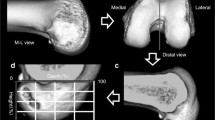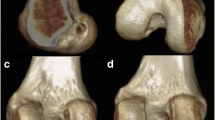Abstract
Purpose
A modified quadrant method was developed for description of femoral tunnel aperture positions on the sagittal plane after double-bundle anterior cruciate ligament (ACL) reconstruction, which can be measured by using two-view radiographs. The purpose of the study is to provide a new measurement method and to evaluate the reproducibility and accuracy of the method.
Methods
Forty-one patients who had undergone a double-bundle ACL reconstruction were investigated. Two-view plain radiographs, a 45-degree-flexion posterior–anterior standing (Rosenberg) and a lateral view, were taken at 1 year postoperatively, and the femoral tunnel positions were measured. Intra- and inter-observer reproducibility was calculated by means of intra-class correlation coefficient (ICC). Also, the accuracy of the method was evaluated by comparing the measurement from three-dimensional computed tomography (3D-CT).
Results
Intra-observer reproducibility was excellent (ICC > 0.9). Inter-observer reproducibility of antero-medial (AM) tunnel position was almost perfect (ICC > 0.8) and that of postero-lateral (PL) tunnel was substantial (ICC > 0.7). The accuracy of the method was assessed by comparing the measurement from 3D-CT and was found to be almost perfect (ICC > 0.8). With the modified quadrant method, the average height of AM and PL tunnels were 17.8 and 44.4 %, respectively, and the depth of AM and PL tunnels were 25.5 and 36.7 %, respectively.
Conclusions
A modified quadrant method was found to have acceptable reproducibility and accuracy. The method is useful for describing the femoral tunnel aperture positions in ACL reconstruction because of its easiness and simplicity. By using this method, it is possible to analyse the femoral tunnel position even in the cases without CT analysis.
Level of evidence
IV.


Similar content being viewed by others
References
Abebe ES, Kim JP, Utturkar GM et al (2011) The effect of femoral tunnel placement on ACL graft orientation and length during in vivo knee flexion. J Biomech 44:1914–1920
Basdekis G, Christel P, Anne F (2009) Validation of the position of the femoral tunnels in anatomic double-bundle ACL reconstruction with 3-D CT scan. Knee Surg Sports Traumatol Arthrosc 17:1089–1094
Bernard M, Hertel P, Hornung H, Cierpinski T (1997) Femoral insertion of the ACL. Radiographic quadrant method. Am J Knee Surg 10: 14–21; discussion 21-12
Colombet P, Robinson J, Christel P et al (2006) Morphology of anterior cruciate ligament attachments for anatomic reconstruction: a cadaveric dissection and radiographic study. Arthroscopy 22:984–992
Giron F, Cuomo P, Aglietti P, Bull AM, Amis AA (2006) Femoral attachment of the anterior cruciate ligament. Knee Surg Sports Traumatol Arthrosc 14:250–256
Hoser C, Tecklenburg K, Kuenzel KH, Fink C (2005) Postoperative evaluation of femoral tunnel position in ACL reconstruction: plain radiography versus computed tomography. Knee Surg Sports Traumatol Arthrosc 13:256–262
Hosseini A, Lodhia P, Van de Velde SK et al (2012) Tunnel position and graft orientation in failed anterior cruciate ligament reconstruction: a clinical and imaging analysis. Int Orthop 36:845–852
Inoue M, Tokuyasu S, Kuwahara S et al (2010) Tunnel location in transparent 3-dimensional CT in anatomic double-bundle anterior cruciate ligament reconstruction with the trans-tibial tunnel technique. Knee Surg Sports Traumatol Arthrosc 18:1176–1183
Iriuchishima T, Ingham SJ, Tajima G et al (2010) Evaluation of the tunnel placement in the anatomical double-bundle ACL reconstruction: a cadaver study. Knee Surg Sports Traumatol Arthrosc 18:1226–1231
Kawaguchi Y, Kondo E, Kitamura N, Kai S, Inoue M, Yasuda K (2011) Comparisons of femoral tunnel enlargement in 169 patients between single-bundle and anatomic double-bundle anterior cruciate ligament reconstructions with hamstring tendon grafts. Knee Surg Sports Traumatol Arthrosc 19:1249–1257
Kawakami Y, Hiranaka T, Matsumoto T et al (2012) The accuracy of bone tunnel position using fluoroscopic-based navigation system in anterior cruciate ligament reconstruction. Knee Surg Sports Traumatol Arthrosc 20:1503–1510
Landis JR, Koch GG (1977) The measurement of observer agreement for categorical data. Biometrics 33:159–174
Lorenz S, Elser F, Mitterer M, Obst T, Imhoff AB (2009) Radiologic evaluation of the insertion sites of the 2 functional bundles of the anterior cruciate ligament using 3-dimensional computed tomography. Am J Sports Med 37:2368–2376
Markolf KL, Hame S, Hunter DM et al (2002) Effects of femoral tunnel placement on knee laxity and forces in an anterior cruciate ligament graft. J Orthop Res 20:1016–1024
Muneta T, Ezura Y, Sekiya I, Yamamoto H (1996) Anterior knee laxity and loss of extension after anterior cruciate ligament injury. Am J Sports Med 24:603–607
Muneta T, Koga H, Mochizuki T et al (2007) A prospective randomized study of 4-strand semitendinosus tendon anterior cruciate ligament reconstruction comparing single-bundle and double-bundle techniques. Arthroscopy 23:618–628
Muneta T, Yamamoto H, Sakai H, Ishibashi T, Furuya K (1993) Relationship between changes in length and force in in vitro reconstructed anterior cruciate ligament. Am J Sports Med 21:299–304
Piasecki DP, Bach BR Jr, Espinoza Orias AA, Verma NN (2011) Anterior cruciate ligament reconstruction: can anatomic femoral placement be achieved with a tarsotibial technique? Am J Sports Med 39:1306–1315
Rosenberg TD, Paulos LE, Parker RD, Coward DB, Scott SM (1988) The forty-five-degree posteroanterior flexion weight-bearing radiograph of the knee. J Bone Jt Surg Am 70:1479–1483
Shino K, Nakata K, Nakamura N et al (2008) Rectangular tunnel double-bundle anterior cruciate ligament reconstruction with bone-patellar tendon-bone graft to mimic natural fiber arrangement. Arthroscopy 24:1178–1183
Steckel H, Musahl V, Fu FH (2010) The femoral insertions of the anteromedial and posterolateral bundles of the anterior cruciate ligament: a radiographic evaluation. Knee Surg Sports Traumatol Arthrosc 18:52–55
Strauss EJ, Barker JU, McGill K, Cole BJ, Bach BR Jr, Verma NN (2011) Can anatomic femoral tunnel placement be achieved using a tarsotibial technique for hamstring anterior cruciate ligament reconstruction? Am J Sports Med 39:1263–1269
van Eck CF, Schreiber VM, Mejia HA et al (2010) “Anatomic” anterior cruciate ligament reconstruction: a systematic review of surgical techniques and reporting of surgical data. Arthroscopy 26:S2–S12
Xu Y, Ao Y, Wang J, Yu J, Cui G (2011) Relation of tunnel enlargement and tunnel placement after single-bundle anterior cruciate ligament reconstruction. Arthroscopy 27:923–932
Yasuda K, Kondo E, Ichiyama H et al (2004) Anatomic reconstruction of the anteromedial and posterolateral bundles of the anterior cruciate ligament using hamstring tendon grafts. Arthroscopy 20:1015–1025
Zantop T, Wellmann M, Fu FH, Petersen W (2008) Tunnel positioning of anteromedial and posterolateral bundles in anatomic anterior cruciate ligament reconstruction: anatomic and radiographic findings. Am J Sports Med 36:65–72
Zavras TD, Race A, Amis AA (2005) The effect of femoral attachment location on anterior cruciate ligament reconstruction: graft tension patterns and restoration of normal anterior–posterior laxity patterns. Knee Surg Sports Traumatol Arthrosc 13:92–100
Author information
Authors and Affiliations
Corresponding author
Rights and permissions
About this article
Cite this article
Horie, M., Muneta, T., Yamazaki, J. et al. A modified quadrant method for describing the femoral tunnel aperture positions in ACL reconstruction using two-view plain radiographs. Knee Surg Sports Traumatol Arthrosc 23, 981–985 (2015). https://doi.org/10.1007/s00167-013-2781-8
Received:
Accepted:
Published:
Issue Date:
DOI: https://doi.org/10.1007/s00167-013-2781-8




